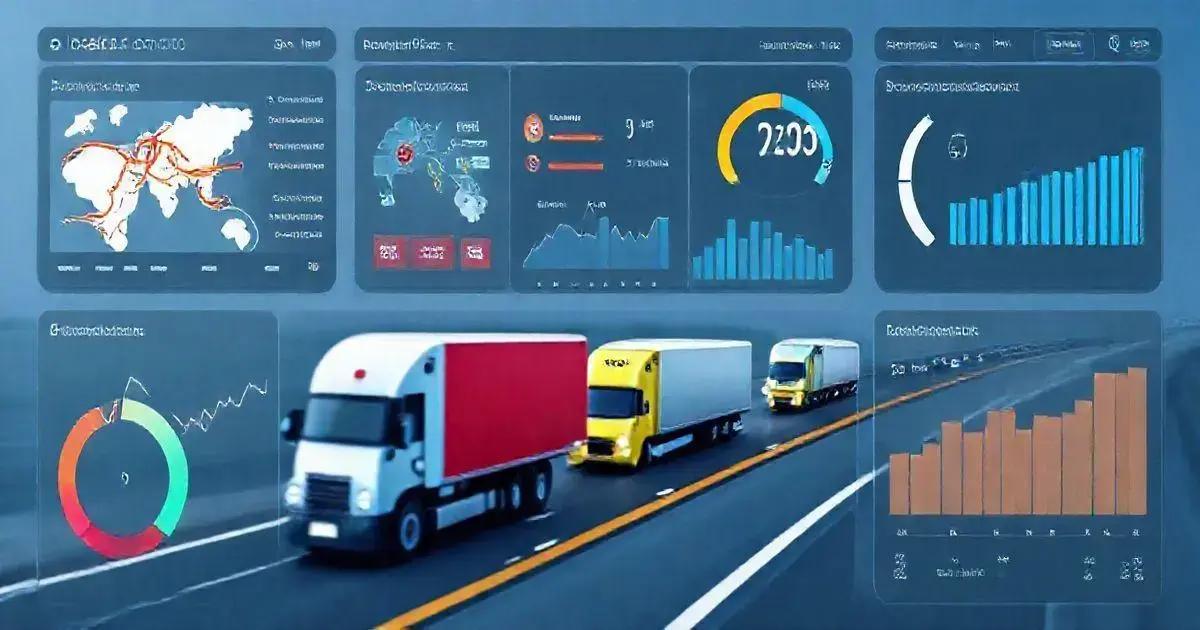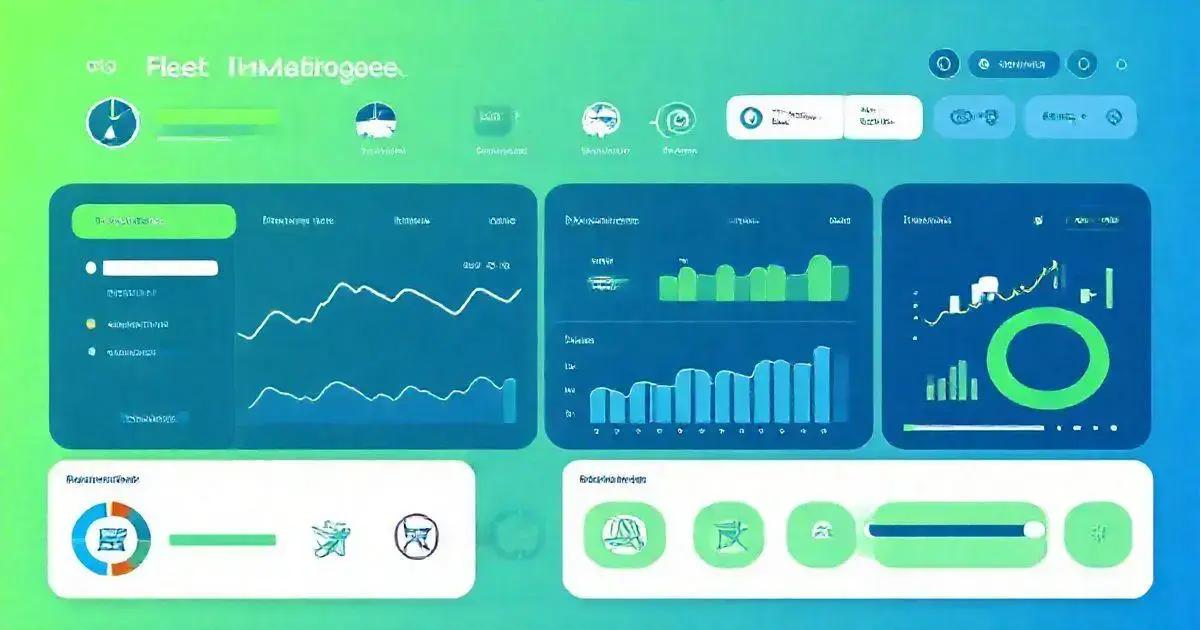10 Key Features of Fleet Control Worksheet 7.0 for Effective Management Leave a comment
The Fleet Control Worksheet 7.0 is a vital tool for fleet management, offering features such as dashboards for tracking kilometers, fuel efficiency, and maintenance costs, cargo management linked to trips, tire tracking for proactive maintenance, detailed maintenance activity tracking, and efficient document management, all within a user-friendly interface compatible with multiple Excel versions, enabling fleet managers to optimize operations and reduce costs.
The Fleet Control Worksheet 7.0 is a powerful tool designed to streamline the management of your fleet operations. With features like travel and cargo control, preventive maintenance tracking, and comprehensive dashboards, this worksheet provides everything you need to keep your fleet running smoothly. In this article, we’ll dive into its key features that can help you optimize your operations and reduce costs.
Initial Dashboards Overview
Initial Dashboards Overview
The Fleet Control Worksheet 7.0 comes equipped with a set of comprehensive initial dashboards that provide you with a clear overview of your fleet’s performance right at your fingertips.
These dashboards are designed to be intuitive, making it easy for fleet managers to monitor key performance indicators and make informed decisions.
Here’s what you can expect from the initial dashboards:
- KM by Driver: Track the kilometers driven by each driver, helping you identify high performers and those who may need additional training.
- KM per Vehicle: Easily view the total kilometers each vehicle has traveled, which aids in maintenance scheduling and fuel efficiency assessments.
- KM per Liter: Monitor fuel consumption with this metric, allowing for better fuel management and cost savings.
- KM per Trip: Analyze the distance covered for each trip, which helps in route optimization.
- Average Consumption per Vehicle: This feature provides insights into how much fuel each vehicle consumes on average, guiding maintenance and operational strategies.
- Average Consumption per Driver: Understanding how much fuel each driver uses can help identify training needs and promote better driving habits.
- Total General, Preventive and Corrective Maintenance: Get a snapshot of all maintenance activities, ensuring that no vehicle is overlooked.
- Maintenance Cost Average: Track average costs of maintenance across the fleet, helping to identify any outliers or issues with specific vehicles.
- Total cost of Mechanical and Electrical Maintenance: This metric shows the cumulative costs associated with all mechanical and electrical repairs, enabling budget adjustments and cost control.
- Total Tire Maintenance Cost: Keeps track of tire expenses, ensuring that you’re aware of any unusual spending patterns.
- Total Lubricant Cost: Understand how much you’re spending on lubricants to ensure optimal vehicle performance.
- Average costs of Mechanical and Electrical Maintenance: This provides an average cost analysis for these maintenance categories, aiding in forecasting and budgeting.
- Average Tire Maintenance Cost: Track average spending on tire maintenance to help with planning and vendor negotiations.
- Average cost with Lubricants: Monitor lubricant spending to ensure it aligns with expected operational costs.
- Vehicles in Transit: A real-time look at which vehicles are currently in operation, helping with dispatch and logistics planning.
- Tires in Transit: Similar to vehicles, this metric tracks the status of your tires, ensuring efficient inventory management.
- Delayed Vehicle Documents: Keep track of any vehicle documents that may be overdue, helping to maintain compliance.
- Delayed Driver Documents: Similar tracking for driver documents helps ensure that all necessary certifications and licenses are current.
- Delayed Preventive Maintenance: This alerts you to any scheduled maintenance that has not been completed on time, preventing costly breakdowns.
- Total Cost Versus Shipping: Analyzes your total costs in relation to shipping performance, providing insights into operational efficiency.
- Fuel, Maintenance and Other Costs: A comprehensive view of all associated costs, helping you to optimize spending and increase profitability.
By utilizing these dashboards, fleet managers can gain actionable insights into their operations, allowing for timely interventions and strategic planning.
The Fleet Control Worksheet 7.0 empowers users by turning data into clear visualizations, setting your fleet management apart from the competition.

Travel and Cargo Control Features
The Fleet Control Worksheet 7.0 offers advanced travel and cargo control features that streamline logistics and enhance operational efficiency. These tools enable fleet managers to oversee every aspect of transportation, ensuring that cargo reaches its destination safely and efficiently.
Here are the key components of the travel and cargo control features:
- Cargo Control Linked to Trips: This feature allows you to easily link cargo to specific trips, ensuring that every shipment is accounted for. You can trace cargo back to individual trips, which is vital for tracking inventory and resolving disputes.
- Vehicle Control: Monitor the status and location of each vehicle in real-time. This not only helps in optimizing routes but also ensures that no vehicle is left unattended, reducing the risk of theft and enhancing security.
- Driver Control: Keep track of which drivers are assigned to specific trips. This feature helps in managing driver schedules and ensuring compliance with legal driving limits, ultimately promoting safety on the road.
- Supply Control: Efficiently manage supplies required for each trip, such as fuel and maintenance resources. This allows for timely replenishment and ensures that drivers have everything they need to complete their assignments.
- Control of All Travel Expenses: Track all expenses associated with each trip, from fuel costs to tolls and maintenance. This comprehensive view helps in effective budgeting and identifying potential areas for cost savings.
By utilizing the travel and cargo control features, fleet managers can ensure a seamless transportation process, resulting in improved customer satisfaction and lower operational costs. The Fleet Control Worksheet 7.0 therefore stands out as a crucial tool for any organization looking to optimize their logistics and fleet management.
Tire Management Made Easy
Tire Management Made Easy
The Fleet Control Worksheet 7.0 simplifies tire management, helping fleet managers maintain optimal tire performance and extend the lifespan of their vehicles. Effective tire management is crucial for ensuring safety, enhancing fuel efficiency, and reducing overall operational costs.
Here are the standout features for tire management within the worksheet:
- Identification for Each Tire: Each tire can be tracked individually, allowing for specific maintenance records and performance monitoring. This feature ensures that fleet managers can quickly identify issues related to specific tires.
- Tire Change Schedule by KM: Set a proactive tire change schedule based on the number of kilometers driven. This helps in ensuring that tires are replaced at the right time, preventing wear and tear that could lead to safety hazards.
- Signal for Remaining KM Until Tire Change: Receive alerts indicating how much longer a tire can be used before it needs to be replaced. This proactive approach helps in planning ahead and reducing downtime due to tire failures.
- Status per Action: Manage the status of each tire regarding its allocation to a vehicle, maintenance needs, and whether it should be scrapped. This comprehensive tracking makes it easy to oversee tire performance and maintenance history.
With these tire management features, the Fleet Control Worksheet 7.0 helps fleet managers ensure that tires are always in optimal condition, reducing the risk of blowouts and improving fuel efficiency. By streamlining tire management, fleets can operate more efficiently and safely, ultimately leading to better performance and lower costs.

Maintenance Control Essentials
The Fleet Control Worksheet 7.0 integrates essential maintenance control features that empower fleet managers to oversee all aspects of vehicle maintenance efficiently. A proactive maintenance strategy is crucial for minimizing vehicle breakdowns, ensuring safety, and extending the life of your fleet.
Here are the fundamental components of maintenance control included in the worksheet:
- Corrective and Preventive Maintenance Type: Differentiate between corrective maintenance (repairs after a breakdown) and preventive maintenance (scheduled maintenance before issues arise). This feature allows managers to create comprehensive maintenance schedules that can prevent costly downtimes.
- Maintenance by Vehicle: Track maintenance records specific to each vehicle, including service types and dates. This detailed record-keeping helps in managing vehicle histories and planning future maintenance activities effectively.
- Maintenance by Mechanical and Electrical Type, Tire and Lubricants: Categorize maintenance based on mechanical, electrical, tire, and lubricant needs, giving a complete view of your fleet’s health and specific service requirements.
- Maintenance Cost: Keep an eye on the total costs associated with maintenance activities, enabling better budgeting and identification of cost-saving opportunities. By monitoring expenses, fleet managers can negotiate better rates with service providers.
- Preventive Maintenance Schedule: Set up a schedule for preventive maintenance tasks, ensuring that vehicles receive timely inspections and services. This proactive approach helps in preventing unexpected failures and ensuring compliance with safety regulations.
- Preventive Maintenance Signal: Get alerts for upcoming preventive maintenance tasks based on mileage or time intervals. These reminders ensure that no maintenance is overlooked, contributing to the overall reliability of your fleet.
- Status by: Scheduled, Accomplished, and Delayed: Monitor the status of maintenance tasks, making it easy to see what’s scheduled, what has been completed, and what may be overdue. This oversight helps in keeping the fleet in ideal working condition.
With the maintenance control essentials provided in the Fleet Control Worksheet 7.0, fleet managers can ensure that their vehicles are well-maintained, thereby enhancing safety, efficiency, and performance. By implementing a robust maintenance strategy, fleets can avoid the significant costs associated with unplanned repairs and maximize their operational effectiveness.
Document Management Tools
The Fleet Control Worksheet 7.0 features robust document management tools that streamline the handling of vital documentation related to your fleet operations. Effective document management is essential for ensuring compliance, enhancing accountability, and protecting your fleet’s assets.
Here’s how the document management tools within the worksheet can benefit fleet managers:
Document Management Tools
- Driver Document Control: Keep track of all essential documents for each driver, including licenses, certifications, and training records. This feature ensures that all driver documents are current and compliant with regulatory requirements, reducing the risk of fines and penalties.
- Vehicle Document Control: Similar to driver documents, this feature allows fleet managers to oversee documentation related to each vehicle, such as registration, insurance, and inspection certificates. This ensures that all vehicles are properly documented and compliant with state and federal regulations.
By utilizing these document management tools, fleet managers can enhance their operational efficiency and ensure that all necessary documentation is readily accessible. The Fleet Control Worksheet 7.0 not only simplifies the tracking of documents but also provides peace of mind, knowing that compliance and accountability are maintained throughout your fleet operations.

User-Friendly Interface and Compatibility
The Fleet Control Worksheet 7.0 is designed with user-friendliness and compatibility in mind, making it accessible to fleet managers of all skill levels. The intuitive interface allows users to navigate through features seamlessly, ensuring that managing fleet operations is efficient and straightforward.
Here’s an overview of the user-friendly aspects and compatibility features:
User-Friendly Interface and Compatibility
- Intuitive Design: The layout is clear and organized, enabling users to find what they need quickly without confusion. Key features are easily accessible, which helps in reducing training time for new users.
- Customizable Dashboards: Users can tailor their dashboards to display the most relevant information for their specific needs. This personalization enhances productivity by allowing managers to focus on metrics that matter most to their fleet.
- Compatible with Excel Versions: The worksheet is compatible with various versions of Excel, including 2007, 2010, 2013, and 2016. This ensures that users can operate the worksheet on their preferred version without compatibility issues.
- Cross-Platform Functionality: Designed to work on Windows operating systems (Windows 7, 8, 8.1, and 10), this worksheet caters to a wide range of users. However, it is important to note that it does not function on tablets or mobile devices, emphasizing the need for a desktop or laptop for optimal performance.
- Easy Data Input and Updates: The interface allows for quick data entry and updates, making it easy to keep all information current. This is crucial for effective fleet management, as real-time data can significantly influence decision-making.
Overall, the Fleet Control Worksheet 7.0 prioritizes user experience through its design and compatibility features, ensuring that fleet managers can efficiently manage their operations without unnecessary complexity. By focusing on ease of use, this worksheet empowers users to make data-driven decisions with confidence.
Conclusion
The Fleet Control Worksheet 7.0 is an essential tool for fleet managers aiming to enhance their operational efficiency and streamline management processes.
With its comprehensive dashboards, effective travel and cargo control features, simplified tire management, robust maintenance control essentials, and powerful document management tools, this worksheet provides everything you need to keep your fleet running smoothly.
Moreover, its user-friendly interface and compatibility with various Excel versions ensure that all users, regardless of technical expertise, can take full advantage of its capabilities.
By implementing the Fleet Control Worksheet 7.0, you can gain valuable insights, reduce costs, and improve overall fleet performance.
Investing in this worksheet means investing in the future success of your fleet management operations.
With its intuitive design and essential features, you’ll be well-equipped to handle the complexities of fleet management and achieve your operational goals.
FAQ – Frequently Asked Questions about Fleet Control Worksheet 7.0
What is the Fleet Control Worksheet 7.0?
The Fleet Control Worksheet 7.0 is a comprehensive spreadsheet tool designed to help fleet managers effectively monitor and manage their fleet operations, including maintenance, travel control, cargo management, and documentation.
Is the Fleet Control Worksheet compatible with my version of Excel?
Yes, the worksheet is compatible with various versions of Excel, including 2007, 2010, 2013, and 2016, ensuring that users can operate it on their preferred version.
Can I customize my dashboard in the Fleet Control Worksheet?
Absolutely! The worksheet allows users to customize their dashboards to display the most relevant metrics for their specific needs, enhancing productivity and focus.
What features does the maintenance control section include?
The maintenance control section includes tracking for corrective and preventive maintenance, maintenance by vehicle, cost monitoring, and scheduling to ensure all vehicles are serviced on time.
How does the tire management feature work?
The tire management feature enables tracking of individual tire performance, scheduling tire changes based on mileage, and providing alerts for tire maintenance, ensuring optimal vehicle safety and efficiency.
Can I access the Fleet Control Worksheet on mobile devices?
No, the Fleet Control Worksheet 7.0 is designed to work on desktop or laptop computers and does not function on tablets or mobile devices.

